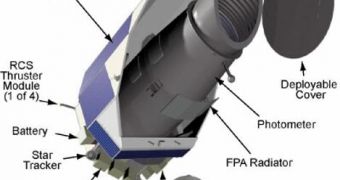The planet-hunting Kepler telescope took another important step recently in its quest for discovering worlds similar to our own, when its protective dust cover was successfully jettisoned. The device covered the NASA-developed photometer, the observatory's main instrument, capable of detecting subtle variations in the brightness of stars, which may be indicators that a planet has temporarily blocked a part of the visible light we can see from Earth.
The variations are so slight that even the most powerful telescopes that were constructed before Kepler could only observe exoplanets that were in orbit around stars relatively close to Earth. Plus, these exoplanets were not observed directly, but through a number of astronomical processes of extrapolation, which the Kepler telescope could bypass.
Named after the German astronomer Johannes Kepler, the observatory was developed by the Ball Aerospace & Technologies Corp., and the science that comes out of it is analyzed and processed at NASA's Ames Research Center, in Moffett Federal Airfield, California.
“Now the photometer can see the stars and will soon start the task of detecting the planets. We have thoroughly measured the background noise so that our photometer can detect minute changes in a star's brightness caused by planets,” William Borucki, the Science principal investigator for the Kepler mission, explained on NASA's website. While the photometer was covered, experts took a series of pictures in the dark, in order to assess exactly how much “noise” the images had. This is important because all of that noise will have to be disregarded when scientists analyze data beamed back by the telescope.
“The telescope's oval-shaped dust cover, measuring 1.7 meters by 1.3 meters (67 inches by 52 inches), protected the photometer from contamination before and after launch. The dust cover also blocked stray light from entering the telescope during launch – light that could have damaged its sensitive detectors. In addition, the cover was important for calibrating the photometer. Images taken in the dark helped characterize noise coming from the instrument's electronics, and this noise will later be removed from the actual science data,” a press release on the American space agency's web page said.
Over the next few weeks, the mission will take a number of control photos of various stars, in an attempt to calibrate the instrument even further. After this time frame, the real scientific observations will begin, and the mission will enter its normal parameters. Kepler is currently following a sun-centric orbit, meaning that it virtually “trails” our planet in its rotation around the star.

 14 DAY TRIAL //
14 DAY TRIAL //